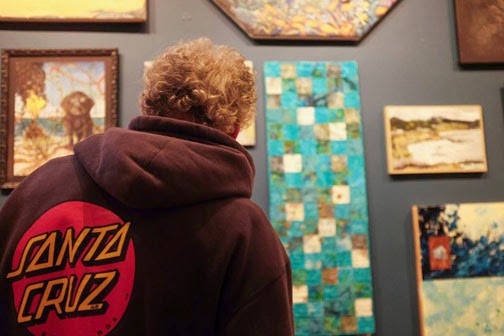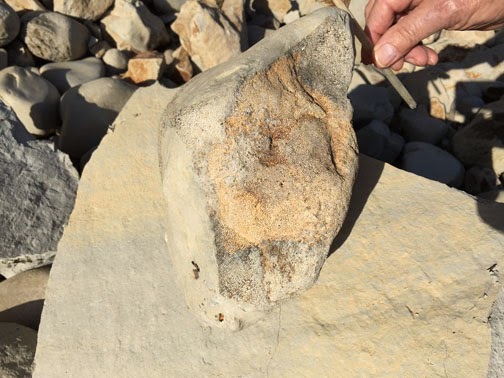In preparation for our upcoming exhibit at the Doug Adams Gallery we were introduced to the CARE community, an affiliate of the Graduate Theological Union. The Center for the Arts, Religion, and Education (CARE), promotes scholarship, reflection, and practice in the arts and religion to serve the Graduate Theological Union.
The party, billed as a "friendraising," certainly was. We were greeted by several old friends and made many new ones. Thanks to our hosts Suzanne and Devin Zuber for making sure that the weather was perfect, the sunset was glorious and the discussions were as dazzling as the sparkling lights of Berkeley, Oakland and beyond. Thanks to Elizabeth Peña and Lily Manderville the party planning was par excellence; with abundant and delectable refreshments to fuel the wide ranging conversations. Thanks to the Hannah and Yohana, volunteer student interns, who have started a blog that will give a behind the scenes look at the development of our project and exhibition. Thanks to Alla Efimova for posting the party pic on her Facebook page.
We were pleased to present the group our "artist statement" for our exhibit, Mining the Collection: Finding Meaning in the Mess:
What we leave behind, what every creature, every culture leaves behind. What the rocks as tales of mountains in motion leave behind. Archeology, Paleontology, Geology. All of these sciences study the remains of something that happened in time, something that left a mark. The fossilized bones of the Archaeopteryx— the Ur bird bridges the "missing link" in the biota of our world. History itself looks into the archives of politics, art, literature; what was left—Cézanne's apples, Mozart's The Magic Flute, the budgetary calamities of Louie XIV, the columns of Persepolis.

When we began thinking about our exhibit at the Doug Adams Gallery/Badé Museum, it was to be a simple exploration of our contemporary archaeology site — Kehoe Beach in the Point Reyes National Seashore. In response to the Tell en-Nasbeh collection we would simply catalogue and sort into some kind of coherence the plastic trash we find washing onto our favorite beach. Limiting ourselves to 1000 meters of that beach as a way of establishing a graspable metric in the welter of planetary bad news. A representative sample of what our culture is leaving behind.
Our search for meaning has taken us from the beach to this august institution, and rightly so. The search for meaning swings toward theology as a way of making sense of an untidy universe.
During our 20 year-long project we've been on an ongoing quest to find out how an aesthetic mind transforms plastic pollution into something meaningful, something beautiful to see. Along the way we've met the texts of powerful thinkers like Mary Douglas, Emile Durkheim, Mircea Eliade who all probe the question, what is allowed inside the Temple, the sacred space, and what must remain outside as the profane, as the "dirt?" We wonder if there is there an alchemy in the creative process linked to transformative action? After collecting over three tons of plastic from one beach we have tuned the simplest action of picking up trash to the highest value of re-enchantment. After all, we call our practice "Stoop Yoga" having bent over and picked every piece of plastic in this exhibit, one piece at a time.
.jpg)
A child walking up the steps of Chicago's Art Institute asks, "Why are there these huge lions outside? This isn't the zoo!" This guileless question unfolds the image of libraries, museums, sanctuaries, shrines, tabernacles beset by toothy beasts. The archetypal guardians. The memorable fanged Bomas of Bali, above every temple doorway, eyes blazing, clawed hands raised in warning, may be just saying. "Booo!" Leave your fear at the door. Or may be saying, "Come in but only bring your best across this threshold." Leave your fear and your greed, pride, gluttony and sloth and the rest of human passion knotted in our ADD culture—come in and feel both your grief for the environmental plight we face as well as a little good humor at the human condition that brought us here.
Lions at the gate? Chapter 7 of the Gospel of Thomas poses: "Blessed is the lion which the man eats, and the lion will become man; and cursed is the man whom the lion eats, and the lion will become man." Bringing this riddle into the sanctuary of the Bade Museum is turning the polemics of anger at consumer recklessness in to the solutions of joy, pleasure and understanding. The joy of discovery, the pleasure of collecting, and turning the hungry lions in our soul toward understanding the mess we have gotten ourselves in to.
Finally, we return to the animistic beginnings when the world was an enchanted place where we can imagine everything/everyone was living in sacred space. Maybe this is a pipe dream but after years of work in our art studios we do know the enchantment of creative thinking leads out into a world where the temple evolves into the whole world, where we can transform the mess into meaning.













.jpg)

.jpg)
















